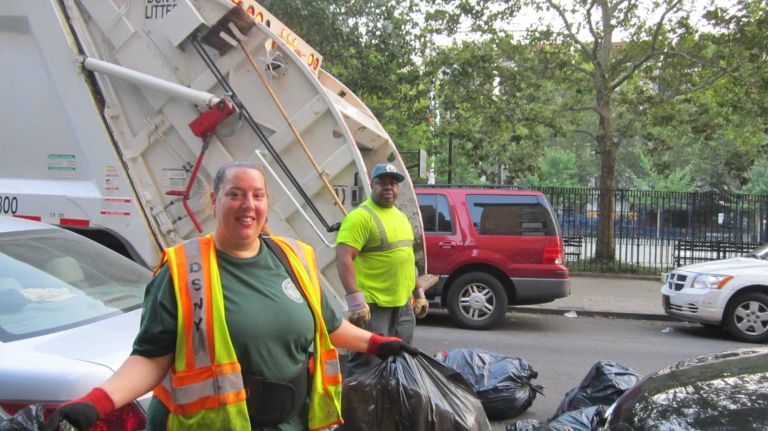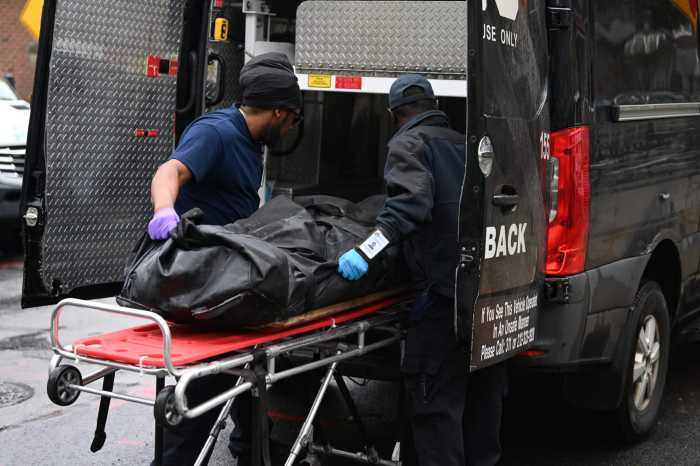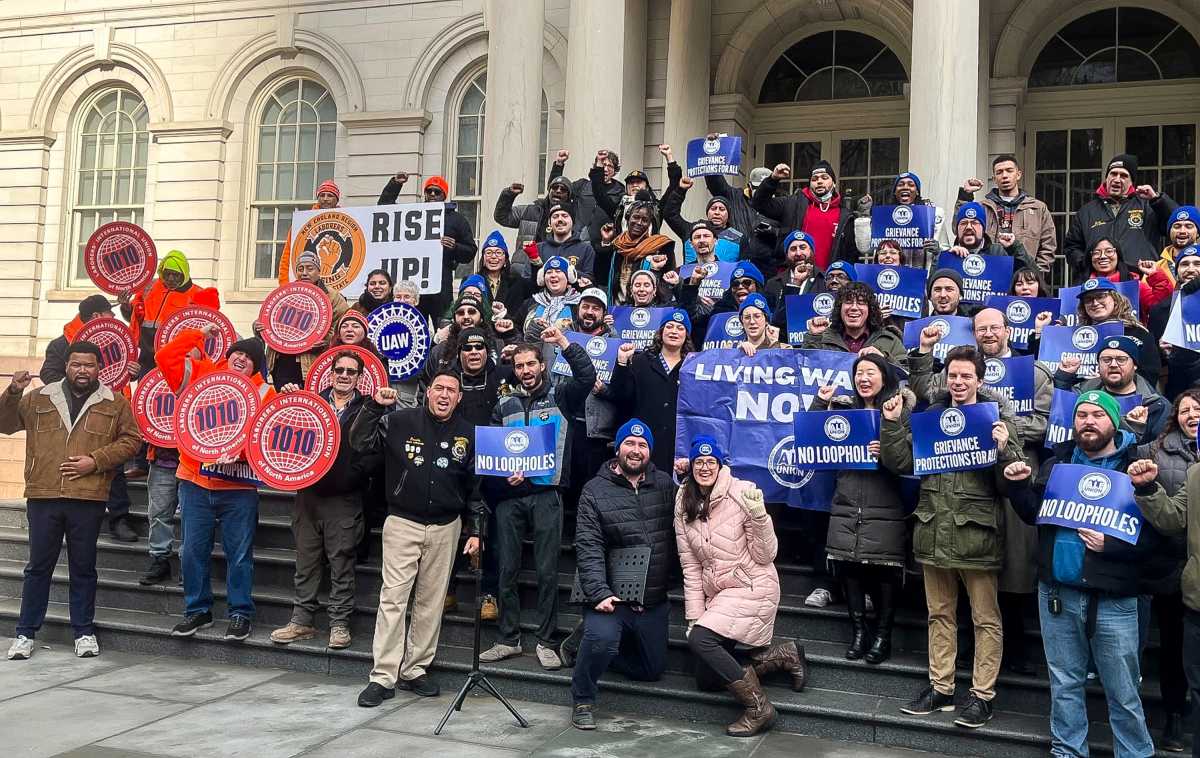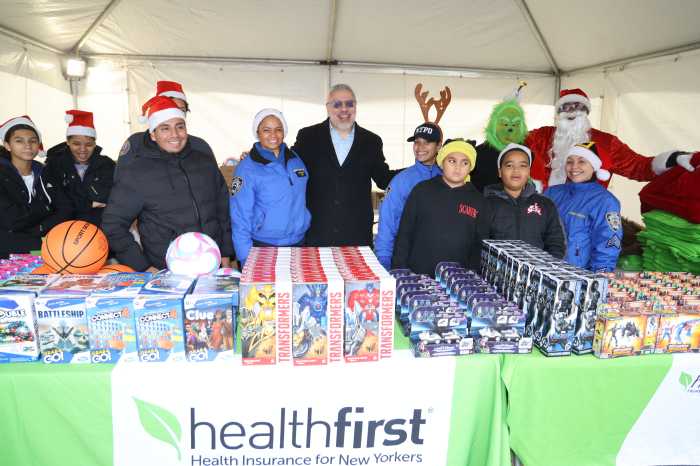
Women began integrating the city’s sanitation department in 1986 and today make up a mere 200 of 7,134 uniformed employees.
While there are always issues in any workplace for any group of under-represented people, women in the sanitation department don’t appear to have encountered the same levels of horrifying hostility that greeted some of their pioneering sisters in other uniformed professions. Why not?
“We’re nicer guys!” offered one supervisor with a shrug and a grin.
Chief Keith Mellis ventured it is because sanitation “is a very family-oriented department.”
True enough. One recent morning, sanitation worker Mary Salierno, 42, of Harlem, confided that her partner of the day, Howard Stewart, 46, had just gotten engaged to her sister, Noelia Alvarado, 37, the weekend before. “Everybody is a brother and sister here — and the older guys are like fathers to us,” said Salierno, who has a 19-year-old daughter and a 24-year-old son plus 15 years on one of the city’s toughest, smelliest jobs.
It’s certainly not the “dancing rice” (maggot swarms that ricochet out of rotting trash), the putrid stench of dead animals and sour milk (“when you pick up at the schools, there’s a lot of sour milk”), or the arduous labor and physical injuries that gratify Salierno, but the fact her job provides for her “that sense of family.”
But it’s also true that the strenuous and incessant nature of the job requires an intense personal collaboration — true teamwork — that fosters a bias-abolishing respect and gratitude for anyone who pulls his or her own weight. “Seen these sausage bags?” asked Salierno, the designated “loader” on the District 10 route in Harlem that day. “They’re usually very heavy.” Stewart instantly bounded out of the cab and the two workers jointly hoisted the weighty stacks of “sausages” that resembled body bags for giants into the truck. Then Salierno began lobbing bulging Hefty bags into the vehicle as if they were softballs — the first ton of an estimated 12 tons of garbage she and Stewart would move that day. “Nobody carries me!” she crowed.
The “compensation package” for New York’s Strongest is the main reason why more than 94,000 people (only 8.4% of them women) applied to take the last Sanitation civil service exam this February.
Starting salary is $35,116 but steps up to $72,153 within 5½ years with overtime and differential opportunities. About 73,000 people actually sat for the test, hoping to land one of the 500 or so openings each year. (Test results have yet to be reported.)
In her best, overtime-rich year Gloria Pabon, 59, one of the first women to join the department, made more than $92,000. “That’s a good pension,” exclaimed Pabon, who now works as an environmental services worker at a hospital and lives in East Stroudsburg, Pennsylvania.
She and Carlen Sanderson, 50, who also started in 1986 and also retired in 2007, are both mystified as to why more women — the housekeepers of the world! — don’t embrace Sanitation as a career, especially because females have fared well in DSNY management: Of the 200 uniformed women DSNY workers, 52 are supervisors. And, notes Commissioner Kathryn Garcia, “our highest ranking uniformed, female employee is Chief Shari Pardini,” – a three-star chief. Protocols are in place to accommodate women who are pregnant or need to pump breast milk, Garcia added in an email.
A “bathroom scandal” involving disgusting conditions in women’s lavatories and locker rooms at several DSNY depots recently prompted the city to spend $3.4 million upgrading female facilities. The veterans acknowledged that the job was tough and they occasionally had to finesse situations they perceived as uncomfortable or unfair, but the gawking and comments of the public were often more irksome than treatment by colleagues.
Male passersby inexplicably think the invitation, “Gurrrrrl, you can pick up my garbage ANY time!” is irresistible to women who tote trash all day. “Like I would want to do that!” exclaimed Sanderson. “I would just smile and say ‘thank you!'” while carrying on, recounted Sanderson, who lives in Springfield Gardens, Queens.
While several marriages have occurred in the Department’s ranks, romance and relationships are sometimes extra hard for women in non-traditional jobs – and not just because of demanding and sometimes unpredictable hours. (Sanitation workers also clear the city streets during snow storms.) “It’s tough: It really is,” to be heralded as “New York’s Strongest” and not intimidate a prospective paramour, said Salierno. Under her industrial, rubber-palmed gloves lurk shiny, feminine silk-wrapped fingernails. Salierno also keeps in touch with her softer side with the aid of a “magic clip” that unfurls a cascade of curls with a single snap.
Sanitation work is indisputably hazardous, exposing workers to threats ranging from bedbugs and parasites to sticks from disease-laden hypodermic needles. Workers suffer both repetitive motion and traumatic injuries.
Salierno received four stitches above her eye after her truck’s compactor spit a jagged piece of furniture into her face in 2005. She dons her “black belt in garbage” — a back support brace with an embedded heating pad — to support a herniated disc even on swelteringly hot days. Sanitation worker Eva Barrientos, 41, a mother of three, was crushed to death in 2004 by her truck’s mechanical lever while trying to dislodge a jammed garbage bag from the gears of her truck.
There is much to be learned about the city through its trash: As multistory luxury condos replace vacant lots, garbage output explodes. Downtown extrudes wine bottles; uptown sheds bottles of the hard stuff. Sanitation workers know that ticky-tacky assembly has replaced quality construction in everything from clothes to furniture. The bright side? Those gorgeous antiques were solid wood and “really heavy,” Salierno recalled. Department rules, incidentally, prohibit workers from “Mongo-ing” or scavenging treasures for themselves from the piles. Once garbage is on the sidewalk, “it belongs to the city,” and workers are not being paid to sift through garbage, but to dump it, Mellis explained.
But the job is a good one, Salierno insisted, in large part because “we have a wonderful union.” Her medical benefits, she exalted, “are so good! We don’t pay anything (for medical care and meds) and if we do, it’s like $5 or $10.” She seemed surprised to find out that the official title of the Teamsters affiliate to which she pays her dues, Local 831, is called “The Uniformed Sanitationmen’s Association.”
“Really?!” she asked.
Yes, she was told. “Oh well!” said Salierno, “I guess they’ll have to change that eventually.”






































